us navy
 The USS Miami (SSN-755) was a Los Angeles-class submarine of the United States Navy. Ships and submarines are commonly named after cities and people, and the USS Miami submarine was the third vessel of the US Navy to be named after Miami, Florida. The USS Miami was also the forty-fourth Los Angeles-class (688) submarine and the fifth Improved Los Angeles-class (688I) submarine to be built and commissioned. The Electric Boat division of General Dynamics Corporation in Groton, Connecticut, won the contract on November 28, 1983. The keel was laid down on October 24, 1986, and USS Miami launched on November 12, 1988. She was commissioned on June 30, 1990 with Commander Thomas W Mader in command.
The USS Miami (SSN-755) was a Los Angeles-class submarine of the United States Navy. Ships and submarines are commonly named after cities and people, and the USS Miami submarine was the third vessel of the US Navy to be named after Miami, Florida. The USS Miami was also the forty-fourth Los Angeles-class (688) submarine and the fifth Improved Los Angeles-class (688I) submarine to be built and commissioned. The Electric Boat division of General Dynamics Corporation in Groton, Connecticut, won the contract on November 28, 1983. The keel was laid down on October 24, 1986, and USS Miami launched on November 12, 1988. She was commissioned on June 30, 1990 with Commander Thomas W Mader in command.
All that is fairly normal and mundane, but USS Miami was to have some much more “exciting” for lack of a better word, times in her future. USS Miami became the first submarine to conduct combat operations in two theaters since World War II, participating in Operation Desert Fox and Operation Allied Force. The submarine also became a movie star when she was featured in The Learning Channel (TLC) Extreme Machine episode on “Nuclear Submarines” but that was not even the craziest event in her history.
On May 23, 2012, at 5:41pm EDT, fire crews were called out with a report of a fire on the USS Miami. At the  time, she was being overhauled at the Portsmouth Naval Shipyard in Kittery, Maine. That would seem like a fairly safe place to be, but I suppose that anytime work is being done, accidents could happen. On that day, USS Miami was in the second month of a scheduled 20-month maintenance cycle. That meant that the “Engineering Overhaul” she was undergoing was extensive. The fire was a major one that injured seven firefighters. In addition, one crew member suffered broken ribs when he fell through a hole left by removed deck plates during the fire. The fire took 12 hours to extinguish.
time, she was being overhauled at the Portsmouth Naval Shipyard in Kittery, Maine. That would seem like a fairly safe place to be, but I suppose that anytime work is being done, accidents could happen. On that day, USS Miami was in the second month of a scheduled 20-month maintenance cycle. That meant that the “Engineering Overhaul” she was undergoing was extensive. The fire was a major one that injured seven firefighters. In addition, one crew member suffered broken ribs when he fell through a hole left by removed deck plates during the fire. The fire took 12 hours to extinguish.
At first, the US Navy said that the blaze was caused by an industrial vacuum cleaner that was used “to clean worksites on the sub after shipyard workers’ shifts” that had sucked up a heat source that ignited debris inside the vacuum. However, on July 23, 2012, civilian painter and sandblaster Casey J Fury was indicted on two counts of arson after confessing to starting the fire. The reason for Fury’s actions really makes no sense to me. Fury said he lit rags on a berthing compartment’s top bunk so he could get out of work early…seriously!! That is insane, but then I guess any reason for arson has a degree of insanity attached to it. Still, this is the most bizarre reason I can think of. For Pete’s sake, tell your boss you need to be off early, or just quit. The consequences of this action were about to be heavy. On March 15, 2013, Fury was sentenced to more than 17 years in federal prison and ordered to pay $400 million in restitution. Casey Fury is still serving his 17-year prison sentence. He is scheduled to be released on August 4, 2027
For more than a year, the USS Miami’s fate was up in the air. Within a month of the fire, Maine Senators Susan 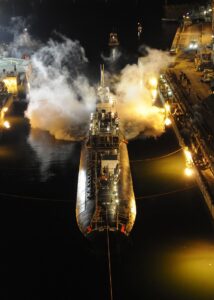 Collins and Olympia Snowe advocated for repairing the submarine. Navy leaders asked Congress to add $220 million to the operations and maintenance budget for emergent and unfunded ship repairs in July 2012. In August, the Navy decided to repair the boat for an estimated total cost of $450 million. They planned to reduce the repair cost by using spare parts from the recently decommissioned USS Memphis and by repairing rather than replacing damaged hull sections, as had been done with another Los Angeles-class boat, USS San Francisco. Unfortunately, these plans wouldn’t work for the USS Miami which was newer and so the parts and such were not available. In the end, the repairs would have cost an estimated $700 million.
Collins and Olympia Snowe advocated for repairing the submarine. Navy leaders asked Congress to add $220 million to the operations and maintenance budget for emergent and unfunded ship repairs in July 2012. In August, the Navy decided to repair the boat for an estimated total cost of $450 million. They planned to reduce the repair cost by using spare parts from the recently decommissioned USS Memphis and by repairing rather than replacing damaged hull sections, as had been done with another Los Angeles-class boat, USS San Francisco. Unfortunately, these plans wouldn’t work for the USS Miami which was newer and so the parts and such were not available. In the end, the repairs would have cost an estimated $700 million.
Finally, on August 6, 2013, the US Navy announced its intention to decommission USS Miami, because the cost was more than it could afford in a time of budget cuts. For the USS Miami it was a sad defeat. The sub was officially decommissioned on March 28, 2014, to be scrapped by the Ship-Submarine Recycling Program.

 It’s not often that a young man “pulls strings” in order to go to war. Most men would rather not go to war, and some will even try to “pull strings” to get out of going. John F Kennedy, who had some health problems, and an old back injury from his college football days, was turned down for the Navy, but his dad managed to pull some strings for his son, who really wanted to go into the navy. Young was desperate, and like most parents, his father wanted to help fulfill that dream. So in 1941, Kennedy’s politically connected father, Joseph Kennedy used his influence to get his sin, John “Jack” into the service. Of course, Joseph might have been thinking ahead to future political maneuvers when he pushed for a military career for his son. Once in the Navy, Kennedy volunteered for PT (motorized torpedo) boat duty in the Pacific in 1942.
It’s not often that a young man “pulls strings” in order to go to war. Most men would rather not go to war, and some will even try to “pull strings” to get out of going. John F Kennedy, who had some health problems, and an old back injury from his college football days, was turned down for the Navy, but his dad managed to pull some strings for his son, who really wanted to go into the navy. Young was desperate, and like most parents, his father wanted to help fulfill that dream. So in 1941, Kennedy’s politically connected father, Joseph Kennedy used his influence to get his sin, John “Jack” into the service. Of course, Joseph might have been thinking ahead to future political maneuvers when he pushed for a military career for his son. Once in the Navy, Kennedy volunteered for PT (motorized torpedo) boat duty in the Pacific in 1942.
“Jack” Kennedy quickly worked to move himself up in rank, and soon he was Lieutenant John F. Kennedy. July 1943 found Lieutenant Kennedy and the crew of PT 109 in combat near the Solomon Islands. People often think that being in the Navy or the Air Force is somehow safer than the Army or Marines, but the reality is that any position in a war 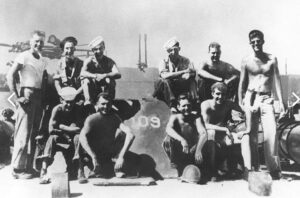
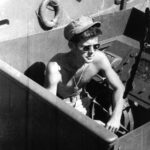 can prove to be dangerous. On August 2, 1943, the middle of the night, Kennedy’s boat was rammed by a Japanese destroyer and caught fire. In the ensuing explosion, several of Kennedy’s shipmates were blown overboard into a sea of burning oil. With no regard for his own life, Kennedy dove in to rescue three of the crew and in the process swallowed some of the toxic mixture. Kennedy always blamed his chronic stomach problems on that incident. The ordeal was not quickly over, and for 12 hours, Kennedy and his men clung to the wrecked hull. Finally, he ordered them to abandon ship. Kennedy and the other good swimmers placed the injured on a makeshift raft. They took turns pushing and towing the raft four miles to safety on a nearby island.
can prove to be dangerous. On August 2, 1943, the middle of the night, Kennedy’s boat was rammed by a Japanese destroyer and caught fire. In the ensuing explosion, several of Kennedy’s shipmates were blown overboard into a sea of burning oil. With no regard for his own life, Kennedy dove in to rescue three of the crew and in the process swallowed some of the toxic mixture. Kennedy always blamed his chronic stomach problems on that incident. The ordeal was not quickly over, and for 12 hours, Kennedy and his men clung to the wrecked hull. Finally, he ordered them to abandon ship. Kennedy and the other good swimmers placed the injured on a makeshift raft. They took turns pushing and towing the raft four miles to safety on a nearby island.
Their ordeal still wasn’t over. For six days, Kennedy and his crew waited on the island for rescue. There was little to eat on the island, but the men survived by drinking coconut milk and rainwater until native islanders discovered the sailors and offered food and shelter. While they waited, Kennedy tried every night to signal other US Navy ships in the area. In addition, Kennedy scrawled a message on a coconut husk and gestured to the islanders to take it to a nearby PT base at Rendova. Finally, on August 8, a Navy patrol boat picked up the survivors of PT-109.
The men were taken to the hospital to recuperate, and on June 12, 1944, while Kennedy was in the hospital recuperating from back surgery, he received the Navy and Marine Corps medal for “courage, endurance, and 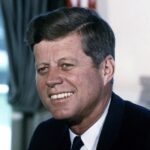
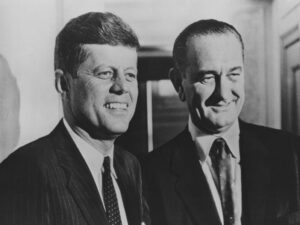 excellent leadership [that] contributed to the saving of several lives and was in keeping with the highest traditions of the United States Naval Service.”
excellent leadership [that] contributed to the saving of several lives and was in keeping with the highest traditions of the United States Naval Service.”
Of course, the rest is history. John F Kennedy went on to become the 35th President of the United States, and on November 22, 1963, Kennedy was assassinated in Dallas. His vice president, Lyndon B Johnson, assumed the presidency upon Kennedy’s death.

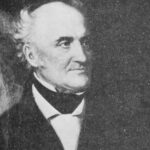 It seems entirely fitting that the first ship in the first navy of the new country, be called after that country. Hense the USS United States was launched on May 10, 1797. USS United States was a wooden-hulled, three-masted heavy frigate of the United States Navy. It was the first of the six original frigates authorized for construction by the Naval Act of 1794. As they were preparing to build the ship, they asked that names be submitted for consideration, and the name “United States” was among the ten such names submitted to President George Washington by Secretary of War Timothy Pickering in March of 1795 for the frigates that were to be constructed. The frigates were designed by Joshua Humphreys to be the young Navy’s capital ships. They would need to be an example of greatness, and so USS United States and her sisters were larger and more heavily armed and built stronger than standard frigates of the period. USS United States ordered on March 27, 1794, built at Humphrey’s shipyard in Philadelphia, Pennsylvania, and launched on May 10, 1797. The USS United States immediately began duties with the newly formed United States Navy protecting American merchant shipping during the Quasi-War with France.
It seems entirely fitting that the first ship in the first navy of the new country, be called after that country. Hense the USS United States was launched on May 10, 1797. USS United States was a wooden-hulled, three-masted heavy frigate of the United States Navy. It was the first of the six original frigates authorized for construction by the Naval Act of 1794. As they were preparing to build the ship, they asked that names be submitted for consideration, and the name “United States” was among the ten such names submitted to President George Washington by Secretary of War Timothy Pickering in March of 1795 for the frigates that were to be constructed. The frigates were designed by Joshua Humphreys to be the young Navy’s capital ships. They would need to be an example of greatness, and so USS United States and her sisters were larger and more heavily armed and built stronger than standard frigates of the period. USS United States ordered on March 27, 1794, built at Humphrey’s shipyard in Philadelphia, Pennsylvania, and launched on May 10, 1797. The USS United States immediately began duties with the newly formed United States Navy protecting American merchant shipping during the Quasi-War with France.
“Joshua Humphreys’ design was deep, long on keel and narrow of beam (width) for mounting very heavy guns. The design incorporated a diagonal scantling (rib) scheme to limit hogging while giving the ships extremely heavy planking. This gave the hull greater strength than those of more lightly built frigates. Humphreys developed his design after realizing that the fledgling United States could not match the navy sizes of the European states. He therefore designed his frigates to be able to overpower other frigates, but with the speed to escape from a ship of the line.”
Of course, as with any naval ship, there is always the possibility of capture, sinking, or destruction. In 1861, 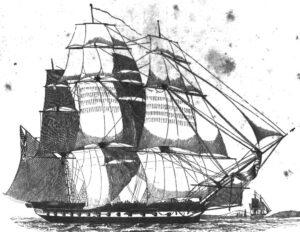 while the USS United States was in port at Norfolk, the Virginia Navy of the Confederacy managed to seize the ship. It was really one of the most hideous acts, if you ask me, for a ship named after this great United States to be stolen by the very group who was trying to tear this nation apart, is a heinous crime. Upon her capture, USS United States was subsequently commissioned into the Confederate navy as CSS United States…which is in itself a contradiction of terms. She was later scuttled by the Confederate forces. After retaking Norfolk, Virginia, the US Navy raised USS United States, but the aged and damaged ship was not able to be returned to service. USS United States was instead held at the Norfolk Navy Yard until she was broken up in December 1865. It was such sad ending for a great ship.
while the USS United States was in port at Norfolk, the Virginia Navy of the Confederacy managed to seize the ship. It was really one of the most hideous acts, if you ask me, for a ship named after this great United States to be stolen by the very group who was trying to tear this nation apart, is a heinous crime. Upon her capture, USS United States was subsequently commissioned into the Confederate navy as CSS United States…which is in itself a contradiction of terms. She was later scuttled by the Confederate forces. After retaking Norfolk, Virginia, the US Navy raised USS United States, but the aged and damaged ship was not able to be returned to service. USS United States was instead held at the Norfolk Navy Yard until she was broken up in December 1865. It was such sad ending for a great ship.
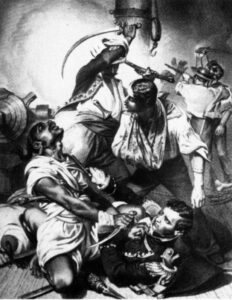
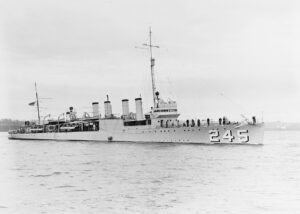 It is common practice in the military to name destroyers (DD) and destroyer Escorts (DE) after Navy and Marine Corps heroes. The USS Reuben James (DD-245) was a four-funnel (four stack) Clemson-class destroyer made after World War I, and it was the first of three US Navy ships named for Boatswain’s Mate Reuben James (1776–1838), who distinguished himself fighting in the First Barbary War. Apparently, on August 3, 1804, James put himself between his commanding officer, Lieutenant Stephen Decatur and the sword of a Tripolitan sailor, who was trying to defend his commander. When James stepped between the descending sword and his commander, he took the blow to his head. Amazingly, the blow did not kill him, and he recovered later to continue serving in the Navy.
It is common practice in the military to name destroyers (DD) and destroyer Escorts (DE) after Navy and Marine Corps heroes. The USS Reuben James (DD-245) was a four-funnel (four stack) Clemson-class destroyer made after World War I, and it was the first of three US Navy ships named for Boatswain’s Mate Reuben James (1776–1838), who distinguished himself fighting in the First Barbary War. Apparently, on August 3, 1804, James put himself between his commanding officer, Lieutenant Stephen Decatur and the sword of a Tripolitan sailor, who was trying to defend his commander. When James stepped between the descending sword and his commander, he took the blow to his head. Amazingly, the blow did not kill him, and he recovered later to continue serving in the Navy.
The Destroyer named after Boatswain’s Mate Reuben James, was the first sunk by hostile action in the European Theater of World War II. The USS Reuben James was laid down on April 2, 1919, by the New York Shipbuilding Corporation of Camden, New Jersey, launched on October 4, 1919, and commissioned on September 24, 1920. the ship was assigned to the Atlantic Fleet. Mainly, it was being used in the Mediterranean Sea during 1921–1922. The ship went from Newport, Rhode Island, on November 30, 1920, to Zelenika, Yugoslavia and arrived on December 18th. It operated in the Adriatic Sea and the Mediterranean out of Zelenika and Gruz (Dubrovnik), Yugoslavia, assisting refugees and participating in post-World War I investigations during the spring and summer of 1921. Then, it joined the protected cruiser Olympia at ceremonies marking the return of the Unknown Soldier to the United States in October 1921 at Le Havre. From October 29, 1921, to February 3, 1922, it assisted the American Relief Administration in its efforts to relieve hunger and misery at Danzig. After completing its tour of duty in the Mediterranean, it departed Gibraltar on July 17th.
Following its tour in the Mediterranean, the ship was based out of New York City, where it routinely patrolled the Nicaraguan coast to prevent the delivery of weapons to revolutionaries in early 1926. During the spring of 1929, it participated in fleet maneuvers that helped develop naval airpower. On January 20, 1931, the Reuben James was
decommissioned at Philadelphia, only to be recommissioned on March 9, 1932. The ship again operated in the Atlantic Ocean and the Caribbean Sea, patrolling Cuban waters during the coup by Fulgencio Batista. Then, in 1934, it was transferred to San Diego. After maneuvers that evaluated aircraft carriers, the Reuben James returned to the Atlantic Fleet in January 1939.
Upon the beginning of World War II in Europe in September 1939, but before the United States joined in the fight, the Reuben James was assigned to the Neutrality Patrol, guarding the Atlantic and Caribbean approaches to the American coast. The ship joined the force established to escort convoys sailing to Great Britain in March 1941. With U-Boat attacks on the rise, this force began escorting convoys as far as Iceland, after which the convoys became the responsibility of British escorts. At that time, it was based at Hvalfjordur, Iceland, commanded by Lieutenant Commander Heywood Lane Edwards.
It would be the escort post that would be the ship in the wrong place at the wrong time. On October 23rd, it sailed from Naval Station Argentia, Newfoundland, with four other destroyers, escorting eastbound Convoy HX 156. All seemed to be going well until, at dawn on October 31st, the Reuben James was torpedoed near Iceland by German U-Boat U-552 commanded by Kapitänleutnant Erich Topp. The Reuben James had positioned itself between an ammunition ship in the convoy and the known position of a German “wolfpack.” The “wolfpack” was a group of submarines poised to attack the convoy. Apparently, the destroyer was not flying the Ensign of the United States, that might have saved it…or maybe not, since it was in the process of dropping depth charges on another U-boat when U-552 engaged. The Reuben James was hit forward by a torpedo meant for a merchant ship and the torpedo blew the entire bow off when a magazine exploded upon the torpedoes impact. The bow of the Reuban James sank immediately. The aft section floated for five minutes before going down. I can only 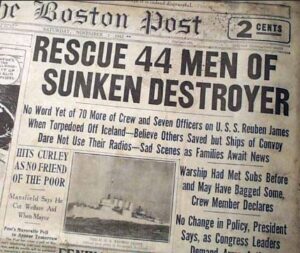
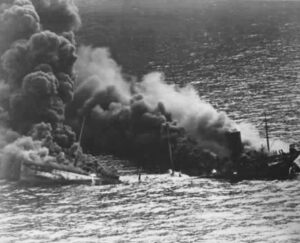 imagine the shock of those around them when the ship was gone so quickly. USS Reuben James carried a crew of seven officers and 136 enlisted men. They also had one enlisted passenger. Of the total of 144 men on board, 100 were killed, including all the officers. Only 44 enlisted men survived the attack. It was the first US warship sunk in World War II, and strangely, the destroyer was sunk before the United States had officially joined the war.
imagine the shock of those around them when the ship was gone so quickly. USS Reuben James carried a crew of seven officers and 136 enlisted men. They also had one enlisted passenger. Of the total of 144 men on board, 100 were killed, including all the officers. Only 44 enlisted men survived the attack. It was the first US warship sunk in World War II, and strangely, the destroyer was sunk before the United States had officially joined the war.

 My husband, Bob Schulenberg’s uncle, Butch Hein served in the US Navy during the Vietnam War. In all the years I have known him, and like most other veterans, Butch never talked about his time during that war. I don’t know where he spent his service years, but the main thing is that he made it home. Once home, Butch began to live the rest of his life.
My husband, Bob Schulenberg’s uncle, Butch Hein served in the US Navy during the Vietnam War. In all the years I have known him, and like most other veterans, Butch never talked about his time during that war. I don’t know where he spent his service years, but the main thing is that he made it home. Once home, Butch began to live the rest of his life.
He married the love of his life, Bonnie Wertz, and together they began planning their future lives. Bonnie soon became pregnant with their first child, and on November 5, 1969, their son, Scott was born. Life was perfect…for a time, but unfortunately it would not stay that way for long. While pregnant with their daughter, Crista, Bonnie was diagnosed with cancer. Like most mom’s she tried to wait it out, so she could give their daughter life, but in the end, both were lost. Butch’s heart was broken, and while he tried to move on with his life, and succeeded with his son, he really was never happy in a relationship again. Bonnie was his forever love. Nevertheless, Butch is very happy with his son. They are best friends and business partners in the ranching business they own together.
Scott grew up and married Terri Wiederrick. They now have three grown children, Laura, Carson, and Lindsey. Butch’s life has made a wonderful turnaround. Having these three grandchildren has been the highlight of his life. Scott built his house on the same property as his dad, so for much of the kids’ lives, they were right beside their grandpa. It was one of the greatest gifts Scott and Terri could have given his dad. Butch has been able to be a big part of his grandchildren’s lives, and they all love him very much.
Now that they are grown, the grandchildren are moving on with their lives. Laura is a teacher and lives a few hours away, Carson is working on a ranch in the area, and Lindsey is away at college. I think the empty nest 
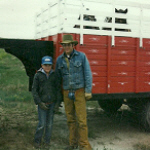 syndrome might apply not only to their parents, but to their grandpa as well. That happens when the grandparents are very close. It happened to me when my own grandchildren became adults, and while we are still close, it is more from a distance these days. I have a feeling Butch is finding himself in the same place. Happy, but a little sad too. Today is Butch’s 77th birthday. Happy birthday Butch. Have a great day!! We love you!!
syndrome might apply not only to their parents, but to their grandpa as well. That happens when the grandparents are very close. It happened to me when my own grandchildren became adults, and while we are still close, it is more from a distance these days. I have a feeling Butch is finding himself in the same place. Happy, but a little sad too. Today is Butch’s 77th birthday. Happy birthday Butch. Have a great day!! We love you!!
 In 1912, the coal transport ship, Jupiter, was transformed, into the US Navy’s first aircraft carrier. The ship was recommissioned USS Langley (CV-1) and was the first aircraft carrier in history. As aircraft carriers go, we would have laughed about the look of this one. This recreated coal transport ship probably should have just stayed a coal transport, but then we wouldn’t have the aircraft carriers we have today, if Jupiter had not been transformed. It all had to start somewhere.
In 1912, the coal transport ship, Jupiter, was transformed, into the US Navy’s first aircraft carrier. The ship was recommissioned USS Langley (CV-1) and was the first aircraft carrier in history. As aircraft carriers go, we would have laughed about the look of this one. This recreated coal transport ship probably should have just stayed a coal transport, but then we wouldn’t have the aircraft carriers we have today, if Jupiter had not been transformed. It all had to start somewhere.
While USS Langley was the first aircraft carrier made, it was not the first to go down in battle. That “honor” goes to HMS Courageous, on September 17, 1939, only a couple weeks after World War II in Europe began. On that day, German U-boat, U-29, sunk the British aircraft carrier with 2 of the 3 torpedoes fired striking the unfortunate carrier. Courageous went down, taking 519 of her crew with her, thereby becoming the first aircraft carrier ever sunk by a submarine. The US Navy’s first aircraft carrier, the Langley, managed to survive until February 27, 1942, when it was sunk by Japanese warplanes (with a little help from US destroyers), and all of its 32 aircraft are lost.
The USS Langley was originally launched in 1912 as the naval collier (coal transport ship) Jupiter. After World 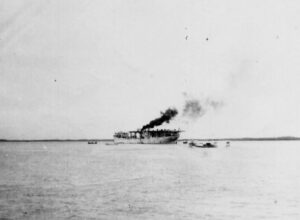 War I, the Jupiter was converted into the Navy’s first aircraft carrier and rechristened the Langley, after aviation pioneer Samuel Pierpont Langley. Uss Langley was the Navy’s first electrically propelled ship. It was capable of speeds of 15 knots. On October 17, 1922, Lieutenant Virgil C Griffin had the great honor of piloting the first plane, a VE-7-SF, from Langley’s decks. Planes had taken off from ships before, but this was a historic moment. The prestige was short-lived, and after 1937, the Langley lost the forward 40 percent of her flight deck as part of a conversion to seaplane tender, a mobile base for squadrons of patrol bombers.
War I, the Jupiter was converted into the Navy’s first aircraft carrier and rechristened the Langley, after aviation pioneer Samuel Pierpont Langley. Uss Langley was the Navy’s first electrically propelled ship. It was capable of speeds of 15 knots. On October 17, 1922, Lieutenant Virgil C Griffin had the great honor of piloting the first plane, a VE-7-SF, from Langley’s decks. Planes had taken off from ships before, but this was a historic moment. The prestige was short-lived, and after 1937, the Langley lost the forward 40 percent of her flight deck as part of a conversion to seaplane tender, a mobile base for squadrons of patrol bombers.
The Langley was part of the Asiatic Fleet in the Philippines when the Japanese attacked on December 8, 1941. Immediately setting sail for Australia, she arrived on January 1, 1942. On February 22nd, under the command of Robert P McConnell, the Langley, carrying 32 Warhawk fighters, left as part of a convoy to aid the Allies in their battle against the Japanese in the Dutch East Indies. Then, on February 27, the Langley parted company 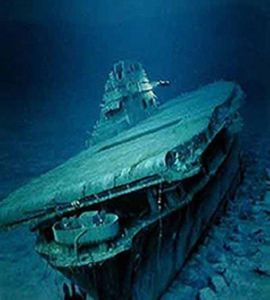 from the convoy and headed straight for the port at Tjilatjap, Java. About 74 miles south of Java, the carrier met up with two US escort destroyers. Then nine Japanese twin-engine bombers attacked the ship. Although the Langley had requested a fighter escort from Java for cover, none could be spared. She and the escort destroyers were virtually alone. The first two Japanese bomber runs missed their target, as they were flying too high, but the third time around they hit their mark three times. The planes on deck went up in flames. The carrier began to list, and Commander McConnell lost his ability to navigate the ship. In an effort to save his men, McConnell ordered the Langley abandoned, and the escort destroyers were able to take his crew to safety. Of the 300 crewmen, only 16 were lost. The destroyers then sank the Langley before the Japanese were able to capture it. It was necessary that they keep it out of Japanese hands. Better at the bottom of the sea that in the hands of the Japanese.
from the convoy and headed straight for the port at Tjilatjap, Java. About 74 miles south of Java, the carrier met up with two US escort destroyers. Then nine Japanese twin-engine bombers attacked the ship. Although the Langley had requested a fighter escort from Java for cover, none could be spared. She and the escort destroyers were virtually alone. The first two Japanese bomber runs missed their target, as they were flying too high, but the third time around they hit their mark three times. The planes on deck went up in flames. The carrier began to list, and Commander McConnell lost his ability to navigate the ship. In an effort to save his men, McConnell ordered the Langley abandoned, and the escort destroyers were able to take his crew to safety. Of the 300 crewmen, only 16 were lost. The destroyers then sank the Langley before the Japanese were able to capture it. It was necessary that they keep it out of Japanese hands. Better at the bottom of the sea that in the hands of the Japanese.

 My niece, Gaby Beach completed her nursing degree with the December 2020 class, and has been hired by Wyoming Medical Center to work in the Progressive Care Unit (PCU). She has wanted to be a nurse for some time now, and once she left the US Navy, has used her GI Bill to realize that dream. Following her graduation, Gaby applied for a job at Wyoming Medical Center, and was quickly hired in the Progressive Care Unit(PCU), which is just a step below ICU. Gaby was hired on the day shift, which is a bit unusual, since many new nurses have to accept the night shift. She starts her new adventure on January 25th.
My niece, Gaby Beach completed her nursing degree with the December 2020 class, and has been hired by Wyoming Medical Center to work in the Progressive Care Unit (PCU). She has wanted to be a nurse for some time now, and once she left the US Navy, has used her GI Bill to realize that dream. Following her graduation, Gaby applied for a job at Wyoming Medical Center, and was quickly hired in the Progressive Care Unit(PCU), which is just a step below ICU. Gaby was hired on the day shift, which is a bit unusual, since many new nurses have to accept the night shift. She starts her new adventure on January 25th.
Gaby and Allen have been renting a loft apartment out in the country while she was not working, but now that they both work at Wyoming Medical Center, it makes more sense for them to live in town. Their next plan is to buy a house in town, but that will have to wait until Gaby is established at the hospital, besides when you think about it, moving in the winter is the pits anyway. For now, Gaby is enjoying being out of school for a while. She will need to go back, because nurses really need to have a Bachelors Degree, and the program she took gives an Associates Degree. Right now, she is looking at her options, because there are requirements the college must have in order to qualify for the GI Bill, and Casper College doesn’t offer the Bachelors Degree for nursing (BSN). Gaby is a person who isn’t likely to put off that part of her training, because she is highly motivated. My guess is that she will be back at it by fall.
For now, she is relaxing, free of her studies, and enjoying her dogs and her plants. Gaby has a definite green thumb when it comes to house plants. She likes the unusual plants, and posts about her success on social 
 media. Her posts have actually turned her hobby into a bit of a business, because people love her posts and her plants so much that she has been able to sell plant shoots for astonishing amounts of money. Her mother-in-law, my sister, Caryl Reed can’t believe anyone would pay that much for a plant clipping. I guess the value of something like that comes from the person selling and the person buying the item. Unusual plants would likely bring more money. However she managed it, Gaby is very talented in nursing and horticulture. Today is Gaby’s birthday. Happy birthday Gaby!! Have a great day!! We love you!!
media. Her posts have actually turned her hobby into a bit of a business, because people love her posts and her plants so much that she has been able to sell plant shoots for astonishing amounts of money. Her mother-in-law, my sister, Caryl Reed can’t believe anyone would pay that much for a plant clipping. I guess the value of something like that comes from the person selling and the person buying the item. Unusual plants would likely bring more money. However she managed it, Gaby is very talented in nursing and horticulture. Today is Gaby’s birthday. Happy birthday Gaby!! Have a great day!! We love you!!
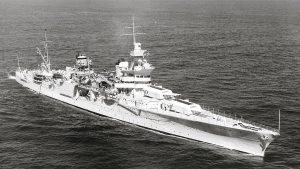 The USS Indianapolis (CL/CA-35) was a Portland-class heavy cruiser of the United States Navy, named for the city of Indianapolis, Indiana. The ship was launched in 1931, the vessel served as the flagship for the commander of Scouting Force 1 for eight years, then as flagship for Admiral Raymond Spruance in 1943 and 1944 while he commanded the Fifth Fleet in battles across the Central Pacific during World War II. Those were tumultuous times, and sometimes things “fell through the cracks,” but what happened to the USS Indianapolis was seriously unthinkable.
The USS Indianapolis (CL/CA-35) was a Portland-class heavy cruiser of the United States Navy, named for the city of Indianapolis, Indiana. The ship was launched in 1931, the vessel served as the flagship for the commander of Scouting Force 1 for eight years, then as flagship for Admiral Raymond Spruance in 1943 and 1944 while he commanded the Fifth Fleet in battles across the Central Pacific during World War II. Those were tumultuous times, and sometimes things “fell through the cracks,” but what happened to the USS Indianapolis was seriously unthinkable.
In July 1945, after the Indianapolis completed a top-secret high-speed trip to deliver parts of Little Boy, the first nuclear weapon ever used in combat, to the United States Army Air Force Base on the island of Tinian, they subsequently departed for Guam and then it was on to the Philippines on training duty. Little Boy was the bomb that was going to effectively end the war, but the war was not over yet, and it was imperative that everyone be on high alert. The waters in many areas of the world were filled with hidden dangers…namely, German U-Boats and Imperial Japanese Navy Submarines. Many a ship was sunk by these hidden enemies.
At 12:05am on July 30, 1945, the USS Indianapolis was torpedoed by the Imperial Japanese Navy submarine I-58, while en route to the Philippines. The mighty ship sank in just 12 minutes. There were 1,195 crewmen aboard, and approximately 300 went down with the ship, unable to get to the deck in time. The remaining 890 men were faced with exposure, dehydration, saltwater poisoning, and shark attacks while stranded in the open ocean with few lifeboats and almost no food or water. The scene was horrible. The men in the water could not necessarily see the sharks, but the screams of their fellow crewmen were unmistakable. And if the crew wasn’t dying by shark attack, they were slowly dying at the hands of the elements. Dehydration caused many to drink the saltwater that was in abundance around them, but soon it poisoned them, and instead of saving them, it killed them.
Because of the speed with which USS Indianapolis sank, there was no time to send a distress signal or even  deploy all of the lifeboats and equipment. The men knew they would need to survive until their ship was overdue and reported missing. They didn’t know how long it would take, and this is where the Navy failed these men. Navy directive 10CL45, which meant no reporting of combatant ships that failed to arrive. No search until by accident someone saw an oil slick. When Indianapolis was overdue, the people who would have reported it as overdue, simply assumed that Indianapolis might have been redeployed to another training area, since that was part of their mission. According to the directive, no search crews were sent out. These men were unthinkably alone in the vast sea…and no help was coming. In fact, the Navy only learned of the sinking four days later, when survivors were spotted by the crew of a PV-1 Ventura on routine patrol. By the time the rescue began, only 316 of the 890 men who survived the original sinking were still alive. The sinking of Indianapolis and Navy directive 10CL45 resulted in the greatest single loss of life at sea from a single ship in the history of the US Navy.
deploy all of the lifeboats and equipment. The men knew they would need to survive until their ship was overdue and reported missing. They didn’t know how long it would take, and this is where the Navy failed these men. Navy directive 10CL45, which meant no reporting of combatant ships that failed to arrive. No search until by accident someone saw an oil slick. When Indianapolis was overdue, the people who would have reported it as overdue, simply assumed that Indianapolis might have been redeployed to another training area, since that was part of their mission. According to the directive, no search crews were sent out. These men were unthinkably alone in the vast sea…and no help was coming. In fact, the Navy only learned of the sinking four days later, when survivors were spotted by the crew of a PV-1 Ventura on routine patrol. By the time the rescue began, only 316 of the 890 men who survived the original sinking were still alive. The sinking of Indianapolis and Navy directive 10CL45 resulted in the greatest single loss of life at sea from a single ship in the history of the US Navy.
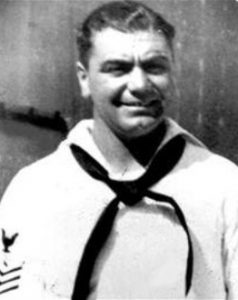 When we think of movie stars, we seldom think of them as soldiers, even if they have played a soldier on television or the movies. Nevertheless, many have served. One of my favorite shows as a kid was McHale’s Navy. McHale was played by Ernest Borgnine, who was born Ermes Effron Borgnino on January 24, 1917, in Hamden, Connecticut. Borgnine was the son of Italian immigrants. His mother, Anna (née Boselli; 1894–c. 1949), was from Carpi, near Modena. His father Camillo Borgnino (1891–1975) was a native of Ottiglio near Alessandria.
When we think of movie stars, we seldom think of them as soldiers, even if they have played a soldier on television or the movies. Nevertheless, many have served. One of my favorite shows as a kid was McHale’s Navy. McHale was played by Ernest Borgnine, who was born Ermes Effron Borgnino on January 24, 1917, in Hamden, Connecticut. Borgnine was the son of Italian immigrants. His mother, Anna (née Boselli; 1894–c. 1949), was from Carpi, near Modena. His father Camillo Borgnino (1891–1975) was a native of Ottiglio near Alessandria.
Borgnine had a normal childhood, and after high school, he enlisted in the United States Navy in October 1935. He served aboard the destroyer/minesweeper USS Lamberton and was honorably discharged from the Navy in October 1941. Then, the 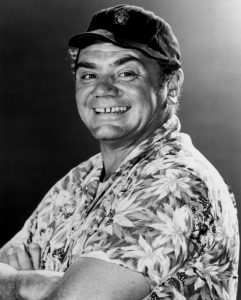 attack on Pearl Harbor on December 7, 1942, changed many things. In January 1942, Borgnine re-enlisted in the Navy. During World War II, he patrolled the Atlantic Coast on an antisubmarine warfare ship, the USS Sylph. In September 1945, he was honorably discharged from the Navy. With the two stints, Borgnine served a total of almost ten years in the Navy and obtained the grade of gunner’s mate 1st class. His military awards include the Navy Good Conduct Medal, American Defense Service Medal with Fleet Clasp, American Campaign Medal with ?3?16″ bronze star, and the World War II Victory Medal. Who knew?
attack on Pearl Harbor on December 7, 1942, changed many things. In January 1942, Borgnine re-enlisted in the Navy. During World War II, he patrolled the Atlantic Coast on an antisubmarine warfare ship, the USS Sylph. In September 1945, he was honorably discharged from the Navy. With the two stints, Borgnine served a total of almost ten years in the Navy and obtained the grade of gunner’s mate 1st class. His military awards include the Navy Good Conduct Medal, American Defense Service Medal with Fleet Clasp, American Campaign Medal with ?3?16″ bronze star, and the World War II Victory Medal. Who knew?
 To me, it seems like all this also prepared him for his most famous television show. As a veteran sailor, he knew how things were run on a ship. Of course, how much of his knowledge could be used on the show depends on the directors. If they had any good sense, they would have used his knowledge, and made the show more realistic. Still, as a kid, I doubt if I would know if it was realistic or not, and after all these years, I can’t say I would recall any of the details. Nor would I know if they were realistic or not. Nevertheless, I always liked the show, and I really liked Ernest Borgnine. I just never knew that he had been a sailor during World War II, or that he had played a part in locating and sinking submarines. I also didn’t realize that he enlisted not once, but twice, or that he served a total of ten years. Years later, on July 8, 2012, after many years as a successful actor, Ernest Borgnine died of kidney failure on July 8, 2012 at Cedars-Sinai Medical Center in Los Angeles, California. He was 95 years old.
To me, it seems like all this also prepared him for his most famous television show. As a veteran sailor, he knew how things were run on a ship. Of course, how much of his knowledge could be used on the show depends on the directors. If they had any good sense, they would have used his knowledge, and made the show more realistic. Still, as a kid, I doubt if I would know if it was realistic or not, and after all these years, I can’t say I would recall any of the details. Nor would I know if they were realistic or not. Nevertheless, I always liked the show, and I really liked Ernest Borgnine. I just never knew that he had been a sailor during World War II, or that he had played a part in locating and sinking submarines. I also didn’t realize that he enlisted not once, but twice, or that he served a total of ten years. Years later, on July 8, 2012, after many years as a successful actor, Ernest Borgnine died of kidney failure on July 8, 2012 at Cedars-Sinai Medical Center in Los Angeles, California. He was 95 years old.
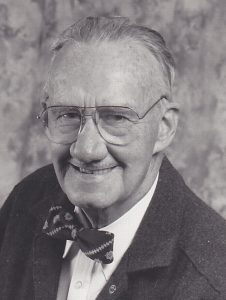 I am amazed at the number of inventions that have changed our world, but when they were invented, they were not what the inventor was trying to invent. Basically, while trying to make one thing, or repair something, the inventor stumbled on something else, and made an important discovery. Wilson Greatbatch was an inventor who had been quite successful, having 150 patents to his credit at the time of his accidental invention. Overall, in his lifetime, he was credited with an astonishing total of 325 patents for his many great brainstorms. Patents aside, Greatbatch will be best remembered for the invention and development of the first implantable pacemaker, a device which has improved, saved, and extended countless lives since its first use in 1960. Worldwide, approximately three million people currently benefit from Greatbatch’s discovery, with an additional 600,000 being implanted every year. It was not what he had be trying to make, however.
I am amazed at the number of inventions that have changed our world, but when they were invented, they were not what the inventor was trying to invent. Basically, while trying to make one thing, or repair something, the inventor stumbled on something else, and made an important discovery. Wilson Greatbatch was an inventor who had been quite successful, having 150 patents to his credit at the time of his accidental invention. Overall, in his lifetime, he was credited with an astonishing total of 325 patents for his many great brainstorms. Patents aside, Greatbatch will be best remembered for the invention and development of the first implantable pacemaker, a device which has improved, saved, and extended countless lives since its first use in 1960. Worldwide, approximately three million people currently benefit from Greatbatch’s discovery, with an additional 600,000 being implanted every year. It was not what he had be trying to make, however.
Wilson Greatbatch was born the son of British immigrants, Warren and Charlotte Greatbatch, in Buffalo, New York, in 1919. He attended school at West Seneca, New York. He had many interests, among which were the sea scouts and amateur radio. Greatbatch was just 16 years old when he received his amateur radio license. During World War II, Greatbatch served in the US Navy as an aviation chief radioman. He took advantage of the 1944 GI Bill to attend Cornell University, where he studied electrical engineering. He graduated in 1950 and began a teaching career at the University of Buffalo in 1952.
It was in 1956, while working at Buffalo, that he made his most important discovery. While it was his most important discovery, it was also the result of an error. Greatbatch had been working on a heart-rhythm recorder, but he mistakenly added an incorrect electronic component. The resulting device produced electrical pulses, instead of simply recording the rhythm. Recalling the event later, he said “I stared at the thing in  disbelief.” Greatbatch realized immediately that he had found a way to electrically simulate and stimulate a heartbeat. It was to become the most important invention of his life, and one that millions of people would be eternally grateful to him for “stumbling upon.”
disbelief.” Greatbatch realized immediately that he had found a way to electrically simulate and stimulate a heartbeat. It was to become the most important invention of his life, and one that millions of people would be eternally grateful to him for “stumbling upon.”
Of course, Greatbatch didn’t make the first pacemaker, but the prior models were bulky, external units which required the use of mains power, basically they had to be plugged into the wall…not conducive to leading an active life. At that time, battery technology was not advanced enough to allow the earlier units to be implanted, and my guess is that they were also big and bulky. Over the following two years Greatbatch managed to miniaturize and package the device so that it could be implanted. In May of 1958, he gave a successful demonstration of the invention in a dog. By 1960 the pacemaker had been implanted in the first human patient, a 77 year old man, who went on to live for another 18 months…not bad for a 77 year old heart patient.
A patent for the implantable pacemaker was granted in 1962, and in 1970 Greatbatch founded Wilson Greatbatch Ltd, which was later renamed now Greatbatch Inc, a company which continues to develop and manufacture lithium-based batteries for pacemakers. Greatbatch himself however, despite now having extensive offices and laboratory facilities, preferred to continue his research at his home garage workshop. He was always a tinkerer, and as he said in an interview with the Associated Press, “Nine things out of 10 don’t work, but the 10th one will pay for the other nine”. When he was asked about the change in quality of life that the pacemaker brought, Greatbatch told his local Buffalo newspaper in 1984, “I think one of my first and most gratifying realizations of what a pacemaker could do was in observing the reactions of elderly people to their grandchildren. People with heart disease generally don’t have enough blood supply to their brains and couldn’t respond before to the bantering of kids.”
Greatbatch was presented with many awards during his lifetime. In 1983 the National Society of Professional 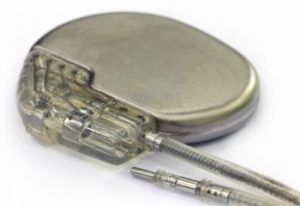 Engineers selected the pacemaker as one of the greatest contributions to society of the previous 50 years. In 1998 Greatbatch was inducted into the National Inventors’ Hall of Fame in Akron, Ohio, alongside his hero Thomas Edison. This was followed, in 2001, by the granting of the highest honor from the National Academy of Engineering, shared with his peer Earl Bakken, who invented the external pacemaker. Greatbatch’s autobiographical account of his discovery, The Making of the Pacemaker: Celebrating a Lifesaving Invention, was published in 2000. Wilson Greatbatch died at the good old age of 92 on September 27, 2011. Greatbatch served as an elder at Clarence Presbyterian Church, where he also sang in the church choir and taught Sunday school.
Engineers selected the pacemaker as one of the greatest contributions to society of the previous 50 years. In 1998 Greatbatch was inducted into the National Inventors’ Hall of Fame in Akron, Ohio, alongside his hero Thomas Edison. This was followed, in 2001, by the granting of the highest honor from the National Academy of Engineering, shared with his peer Earl Bakken, who invented the external pacemaker. Greatbatch’s autobiographical account of his discovery, The Making of the Pacemaker: Celebrating a Lifesaving Invention, was published in 2000. Wilson Greatbatch died at the good old age of 92 on September 27, 2011. Greatbatch served as an elder at Clarence Presbyterian Church, where he also sang in the church choir and taught Sunday school.

